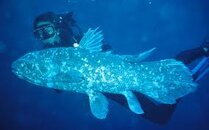You are using an out of date browser. It may not display this or other websites correctly.
You should upgrade or use an alternative browser.
You should upgrade or use an alternative browser.
Wildlife fans: Why do you go deep?
- Thread starter gsk3
- Start date
Please register or login
Welcome to ScubaBoard, the world's largest scuba diving community. Registration is not required to read the forums, but we encourage you to join. Joining has its benefits and enables you to participate in the discussions.
Benefits of registering include
- Ability to post and comment on topics and discussions.
- A Free photo gallery to share your dive photos with the world.
- You can make this box go away
Deep diving here off of the Big Island of Hawaii offers the opportunity to see species of fish whose usual habitat is deeper than recreational limits, e.g. the Tinker's Butteryfly and the endemic Bandit Angelfish. Also, much of the black coral within recreational limits here has been collected, leaving only a few specimens in deeper water. Here's an excerpt of some video I shot of two Longnose Hawkfish in a bush of black coral at 195 FSW. Ambient light, red filter.
[video=vimeo;32530015]http://vimeo.com/32530015[/video]
[video=vimeo;32530015]http://vimeo.com/32530015[/video]
Dive Bug Bit Me
Contributor
Out here in South Africa, the thing to do is go see the living fossil, a Coelacanth.
They are extremely rare and found below about 280 ft. The trip usually involves a series of dives to these depths with maximum bottom time because you are poking your head into holes and overhangs to try find the fish. No, I am not anywhere near ready for this dive so have not seen one in the wild.
From Advanced Diver Magazine;

They are extremely rare and found below about 280 ft. The trip usually involves a series of dives to these depths with maximum bottom time because you are poking your head into holes and overhangs to try find the fish. No, I am not anywhere near ready for this dive so have not seen one in the wild.
From Advanced Diver Magazine;
The living fossil fish Coelacanth (Latimeria chalumnae) is regarded as an extremely rare species. Only fossil records of Coelacanths were known until the famous discovery in 1938 in South Africa. The second fish was caught 53 years later in Mozambique, but thereafter more specimens have been caught off the coasts of the Comoros, Madagascar, Kenya, and recently Tanzania.
Underwater studies off the coast of South Africa, using submersible vessels, revealed that Coelacanths inhabit submarine caves and canyons found in slopes and walls in waters 100-700 meters deep. The adult Coelacanths can grow to about 1.5 meter long. They appear to be active at night, spending their day hovering near the ocean bottom. Scientists believe that Coelacanths can live as long as 80 years.

Similar threads
- Replies
- 39
- Views
- 7,146
Trip Report
Puerto Rico - The Wall at La Parguera
- Replies
- 32
- Views
- 2,808
- Replies
- 2
- Views
- 898
- Replies
- 12
- Views
- 1,834




